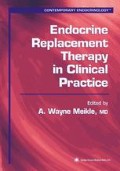Abstract
Aldosterone, the most important mineralocorticoid in humans, is produced in the zona glomerulosa of the adrenal cortex. It acts on the principal cells of the distal convoluted tubule of the kidney, intestine, and salivary gland to stimulate sodium absorption and potassium excretion. The adrenocortical steroidogenic cells of the zona glomerulosa are unique in that they express aldosterone synthase (18-hydroxylase) activity, which converts corticosterone to aldosterone. On the other hand, these cells lack 17α-hydroxylase activity, which is present in the cortisol-producing zona fasciculata.
Access this chapter
Tax calculation will be finalised at checkout
Purchases are for personal use only
Preview
Unable to display preview. Download preview PDF.
References
Tan SY, Burton M. Hyporeninemic hypoaldosteronism. An overlooked cause of hyperkalemia. Arch Intern Med 1981; 141: 30–33.
Schambelan M, Stockigt JR, Biglieri EG. Isolated hypoaldosteronism in adults: a renin-deficiency syndrome. N Engl J Med 1972; 287: 573.
DeFronzo RA, Bia M, Smith D. Clinical disorders of hyperkalemia. Annu Rev Med 1982; 33: 521–554.
Gordon RD. Syndrome of hypertension and hyperkalemia with normal glomerular filtration rate. Hypertension 1986; 8: 93.
Mansfield TA, Simon DB, Farfel Z, Bia M, Tucci JR, Lebel M, et al. Multilocus linkage of familial hyperkalaemia and hypertension, pseudohypoaldosteronism type II, to chromosomes 1q31–42 and 7p11-q21. Nat Genet 1997; 16 (2): 202–205.
Schambelan M, et al. Mineralocorticoid-resistant renal hyperkalemia without salt-wasting (type II pseudohypoaldosteronism): Role of increased renal chloride reabsorption. Kidney Int 1981; 19: 716.
Oelkers W. Adrenal insufficiency. N Engl J Med 1996; 335: 1206–1212.
Guy RJ, Turberg Y, Davidson RN, et al. Mineralocorticoid deficiency in HIV infection. Br Med J 1989; 298: 496–497.
Dahlberg PJ, Goellner MH, Pehling GB. Adrenal insufficiency secondary to adrenal hemorrhage. Two case reports and a review of cases confirmed by computed tomography. Arch Intern Med 1990; 150: 905–909.
Agmon D, Green J, Platau E, et al. Isolated adrenal mineralocorticoid deficiency due to amyloidosis associated with familial Mediterranean fever. Am J Med Sci 1984; 288: 40–43.
Zipser RD, Davenport MW, Martin KL, et al. Hyperreninemic hypoaldosteronism in the critically ill: a new entity. J Clin Endocrinol Metab 1981; 53: 867–873.
Biglieri EG, Schambelan M, Slaton Jr. PE. Effect of adrenocorticotropin on desoxycorticosterone, corticosterone and aldosterone excretion. J Clin Endocrinol Metab 1969; 29: 1091.
Kraiem Z, Rosenthal T, Rotzak R, et al. Angiotensin II and K challenge followed by prolonged ACTH administration in normal subjects. ACTA Endocrinol (Copenh) 1979; 91: 657.
Slater JDH, Tuffley RE, Williams ES, et al. Control of aldosterone secretion during acclimatization to hypoxia in man. Clin Sci 1969; 37: 237.
Nomoto S, Massa G, Mitani F, et al. CMO I deficiency caused by a point mutation in exon 8 of the human CYP11B2 gene encoding steroid 18-hydroxylase (P450C18). Biochem Biophys Res Commun 1997;234(2:)382–385.
Mitsuuchi Y, Kawamoto T, Miyahara K, et al. Congenitally defective aldosterone biosynthesis in humans: inactivation of the P-450C 18 gene (CYP 11 B2) due to nucleotide deletion in CMO I deficient patients. Biochem Biophys Res Commun 1993;190:(3)864–869.
Peter M, Fawaz L, Drop SLS, et al. A prismatic case. Hereditary defect in biosynthesis of aldosterone: aldosterone synthase deficiency 1964–1997. J Clin Endocrinol Metab 1997; 82 (11): 3525–3528.
Mitsuuchi Y, Kawamoto T, Naiki Y, et al. Congenitally defective aldosterone biosynthesis in humans• the involvement of point mutations of the P-450C18 gene (CYP11B2) in CMO II deficient patients. Biochem Biophys Res Commun 1992; 182 (2): 974–979.
Peter M, Sippel WG. Congenital hypoaldosteronism: the Visser-Cost-Syndrome revisited. Pediatr Res 1996; 39: 554–560.
Yong AB, Montalto J, Pitt J, et al. Corticosterone methyl oxidase type II (CMO II) deficiency: biochemical approach to diagnosis. Clin Biochem 1994;27:(6)491–494.
Cheek DB, Perry JW. A salt-wasting syndrome in infancy. Arch Dis Child 1958; 33: 252.
Chang SS, Grunder S, Hanukoglu A, et al. Mutations in subunits of the epithelial sodium channel cause salt wasting with hyperkalaemic acidosis, pseudohypoaldosteronism type 1. Nat Genet 1996;12:(3)248–253.
Oberfield SE, et al. Pseudohypoaldosteronism: multiple target organ unresponsiveness to mineralocorticoid hormones. J Clin Endocrinol Metab 1979; 48: 228.
Saruta T, Kaplan NM. Adrenocortical steroidogenesis: the effects of prostaglandins. J Clin Invest 1972; 51: 2246.
Franco-Saenz R, et al. Prostaglandins and renin production: a review. Prostaglandins 1980; 20: 1131.
Holdaas H, Dibona GF, Kiil F. Effect of low-level renal nerve stimulation on renin release from non-filtering kidneys. Am J Physiol 1981; 241: F156 - F161.
Gross R, Hackenberg HM, Hackenthal E, et al. Interaction between perfusion pressure and sympathetic nerves in renin release by carotid baroreflex in conscious dogs. J Physiol 1981; 313: 237–250.
Oster JR, Singer I, Fishman LM. Heparin-induced hypoaldosteronism and hyperkalemia. Am J Med 1995; 98 (6): 575–586.
Aull L, Chao H, Coy K. Heparin-induced hyperkalemia. DICP 1990; 24: 244–246.
Levesque H, Verdier S, Cailleux N, et al. Low molecular weight heparins and hypoaldosteronism. Br Med J 1990; 300: 1437–1438.
Sequeira SJ, McKenna Ti. Chlorbutal, a new inhibitor of aldosterone biosynthesis identified during examination of heparin effect on aldosterone production. J Clin Endocrinol Metab 1986; 63 (6): 780–784.
Azukizawa S, Iwasaki I, Kigoshi T, et al. Effects of heparin treatments in vivo and in vitro on adrenal angiotensin II receptors and angiotensin II-induced aldosterone production in rats. ACTA Endocrinol (Copenh) 1988; 119 (3): 367–372.
Velazquez H, Perazella MA, Wright FS, et al. Renal mechanism of trimethoprim-induced hyperkalemia. Ann Intern Med 1993; 119 (4): 296–301.
Clark BA, Brown RS. Potassium homeostasis and hyperkalemic syndromes. Endocrinol Clin N Am 1995; 24 (3): 573–591.
Editor information
Editors and Affiliations
Rights and permissions
Copyright information
© 2003 Springer Science+Business Media New York
About this chapter
Cite this chapter
Dluhy, R.G. (2003). Mineralocorticoid Deficiency Syndromes. In: Meikle, A.W. (eds) Endocrine Replacement Therapy in Clinical Practice. Contemporary Endocrinology. Humana Press, Totowa, NJ. https://doi.org/10.1007/978-1-59259-375-0_17
Download citation
DOI: https://doi.org/10.1007/978-1-59259-375-0_17
Publisher Name: Humana Press, Totowa, NJ
Print ISBN: 978-1-61737-416-6
Online ISBN: 978-1-59259-375-0
eBook Packages: Springer Book Archive

